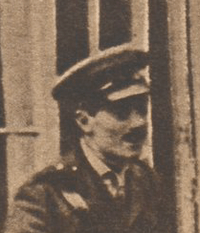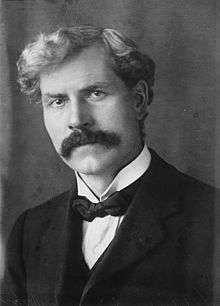Christopher Thomson, 1st Baron Thomson
| The Right Honourable The Lord Thomson PC | |
|---|---|
|
as defence attache in Bucharest | |
| Secretary of State for Air | |
|
In office 22 January 1924 – 3 November 1924 | |
| Monarch | George V |
| Prime Minister | Ramsay MacDonald |
| Preceded by | Sir Samuel Hoare, Bt |
| Succeeded by | Sir Samuel Hoare, Bt |
|
In office 7 June 1929 – 5 October 1930 | |
| Monarch | George V |
| Prime Minister | Ramsay MacDonald |
| Preceded by | Sir Samuel Hoare, Bt |
| Succeeded by | The Lord Amulree |
| Personal details | |
| Born |
13 April 1875 Nasik, British India |
| Died |
5 October 1930 (aged 55) Allone, France |
| Resting place | Cardington, Bedfordshire |
| Nationality | British |
| Political party | Labour |
Christopher Birdwood Thomson, 1st Baron Thomson PC (13 April 1875 – 5 October 1930) was a British Army officer who went on to serve as a Labour minister and peer. He served as Secretary of State for Air under Ramsay MacDonald in 1924 and between 1929 and 1930, when he was killed in the R101 disaster.
Early life
Born in Nasik (now Nashik) in the Bombay Presidency of India to a military family, Thomson attended Cheltenham College. His father was Major-General David Thompson, Royal Engineers, and his mother was the daughter of Major-General Christopher Birdwood; William Birdwood, 1st Baron Birdwood was another grandson of Major-General Birdwood.[1]
Career
Military
After graduating from the Royal Military Academy, Woolwich, in 1894, Thomson was commissioned into the Royal Engineers. He served first in Mauritius and then saw action during the Second Boer War (1899-1902) during which he was in command of a field company section and was mentioned in dispatches. He also had his first encounter with aviation when he was detailed to help with the RE Balloon Section outside Kimberley.[2] After the war he became an instructor at the School of Military Engineering at Chatham and then at Sierra Leone. He was promoted to captain and brevet major in 1904 and in 1909 joined the Army Staff College in Camberley. In 1911 he went to the War Office, and in 1912 Thomson was appointed military attaché with the Serbian army during the first and Second Balkan Wars, after which he returned to the War Office in 1913.[3]
During the First World War Thomson first served at the British Expeditionary Force Headquarters and was Chief Military Interpreter between Sir John French and General Joffre. In 1915 he was sent to Bucharest as military attaché on Kitchener's initiative to bring Romania into the war. But when there he quickly formed the view that an unprepared and ill-armed Romania facing a war on three fronts against Austria-Hungary, Turkey and Bulgaria would be a liability rather than an asset to the allies. This view was brushed aside by Whitehall, and he signed a Military Convention with Romania on 13 August 1916. By the end of 1916 he had to alleviate the consequences of Romania's capitulation, and he supervised the destruction of the Romanian oil wells to deny them to Germany.[4]
After a distinguished wartime career both behind the lines and in at the front, most notably at Jericho in the Palestine Campaign, Thomson formed part of the British delegation at the Versailles conference, but condemned the Versailles terms as "containing the seeds of another war." As in Romania where he followed a policy (of making Romania an ally) that he did not agree with, he found both experiences profoundly negative.[5]
Politics
After Versailles Thomson made the decision to enter politics, and joined the Labour Party and Fabian Society. He stood as Labour candidate in two Tory strongholds, Bristol Central in 1922 and St Albans in 1923, but failed to win either seat.[6] In 1924, however, newly elected Labour Prime Minister Ramsay Macdonald elevated him to the peerage as Baron Thomson, of Cardington in the County of Bedford.[7] He was sworn of the Privy Council at the same time.[8] He served as Secretary of State for Air in Macdonald's first short lived Labour administration of 1924[9] - interrupting briefly Sir Samuel Hoare's seven year grip on the post. The fall of the government meant that it was not until 1929 that he regained the position, once again serving under Macdonald.[10] In the interim he had maintained his air interests acting as chairman of the Royal Aeronautical Society and the Royal Aero Club, and patron of the Air League.[11]
Private life
Thomson was known as Kit to his family and C. B. to his friends. In March 1915 while British military attache in Bucharest, he met the (married) French-Romanian author Princess Marthe Bibesco, and remained devoted to her for the rest of his life. They corresponded regularly. She dedicated four books to "C.B.T." and visited the site of the R101 accident with their mutual friend the Abbé Mugnier in December 1930.[12]
Death
His second term in office was cut short by tragedy as Thomson died in the crash of the R101 airship, a government designed dirigible, on its maiden flight to Karachi in October 1930. The accident claimed the lives of 48 people and led to the cancellation of the British airship programme by Thomson's successor as air minister, Lord Amulree.
Styles of address
- 1875-1924: Mr Christopher Thomson
- 1924: The Right Honourable Christopher Thomson[13]
- 1924-1930: The Right Honourable The First Lord Thomson PC[14]
| Political offices | ||
|---|---|---|
| Preceded by Sir Samuel Hoare, Bt |
Secretary of State for Air 1924 |
Succeeded by Sir Samuel Hoare, Bt |
| Preceded by Sir Samuel Hoare, Bt |
Secretary of State for Air 1929–1930 |
Succeeded by The Lord Amulree |
| Peerage of the United Kingdom | ||
| New creation | Baron Thomson 1924 – 1930 |
Extinct |
References
- ↑ Masefield 1982, p.15
- ↑ Masefield 1982, p. 14
- ↑ Onslow, rev. Robin Higham "Thomson, Christopher Birdwood, Baron Thomson (1875–1930)", Oxford Dictionary of National Biography, Oxford University Press, 2004; online edn, Jan 2011 accessed 2 June 2014
- ↑ Sir Peter G. Masefield, To Ride the Storm: The Story of the Airship R.101, p.15-17 (1982, William Kimber, London) ISBN 0-7183-0068-8
- ↑ Obituary, Daily Telegraph
- ↑ Masefield 1982, p.21
- ↑ The London Gazette: no. 32907. p. 1265. 12 February 1924.
- ↑ The London Gazette: no. 32901. p. 769. 25 January 1924.
- ↑ The London Gazette: no. 32901. p. 770. 25 January 1924.
- ↑ The London Gazette: no. 33505. p. 3856. 11 June 1929.
- ↑ Masefield 1982, p.35
- ↑ Masefield 1982, pp. 18-20, 36, 415
- ↑ The London Gazette: no. 32901. p. 769. 25 January 1924.
- ↑ The London Gazette: no. 32907. p. 1265. 12 February 1924.
Bibliography
- Onslow, Rev.Robin Higham (Jan 2011) [2004]. "Thomson, Christopher Birdwood, Baron Thomson (1875–1930)". Oxford Dictionary of National Biography (online edn ed.). Oxford University Press. Retrieved 2 June 2014.

